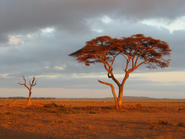Geography[edit]
Somaliland is situated in northwestern Somalia. It lies between the 08°00' – 11°30' parallel north of the equator and between 42°30' – 49°00' meridian east of Greenwich. It is bordered by Djibouti to the west, Ethiopia to the south, and the Puntland region of Somalia to the east. Somaliland has a 740 kilometres (460 mi) coastline with the majority lying along the Gulf of Aden. The region is slightly larger than England, with an area of 137,600 km2 (53,100 sq mi).
Somaliland's climate is a mixture of wet and dry conditions. The northern part of the region is hilly, and in many places the altitude ranges between 900 and 2,100 metres (3,000 and 6,900 ft) above sea level. The Awdal, Sahil and Maroodi Jeex (Woqooyi Galbeed) regions are fertile and mountainous, while Togdheer is mostly semi-desert with little fertile greenery around. The Awdal region is also known for its offshore islands, coral reefs and mangroves.
A scrub-covered, semi-desert plain referred as the Guban lies parallel to the Gulf of Aden littoral. With a width of twelve kilometers in the west to as little as two kilometers in the east, the plain is bisected by watercourses that are essentially beds of dry sand except during the rainy seasons. When the rains arrive, the Guban's low bushes and grass clumps transform into lush vegetation.[77] This coastal strip is part of the Ethiopian xeric grasslands and shrublands ecoregion.
Cal Madow is a mountain range in the northern part of the country. Extending from the northwest of Erigavo to several kilometers west of the city of Bosaso, it features Somalia's highest peak, Shimbiris, which sits at an elevation of about 2,416 metres (7,927 ft).[3] The rugged east-west ranges of the Karkaar Mountains also lie to the interior of the Gulf of Aden littoral.[77] In the central regions, the northern mountain ranges give way to shallow plateaus and typically dry watercourses that are referred to locally as theOgo. The Ogo's western plateau, in turn, gradually merges into the Haud, an important grazing area for livestock.[77]


No comments:
Post a Comment